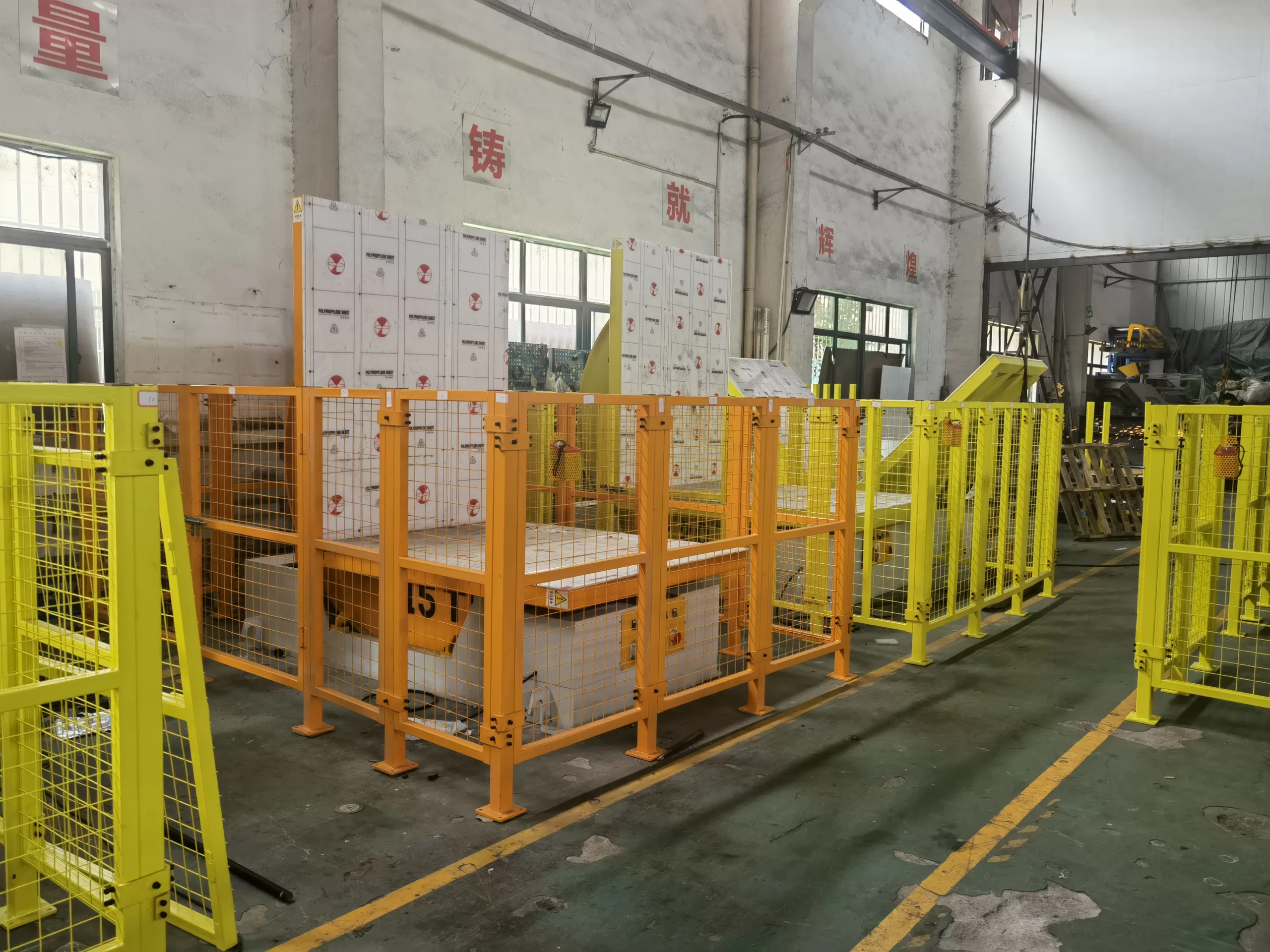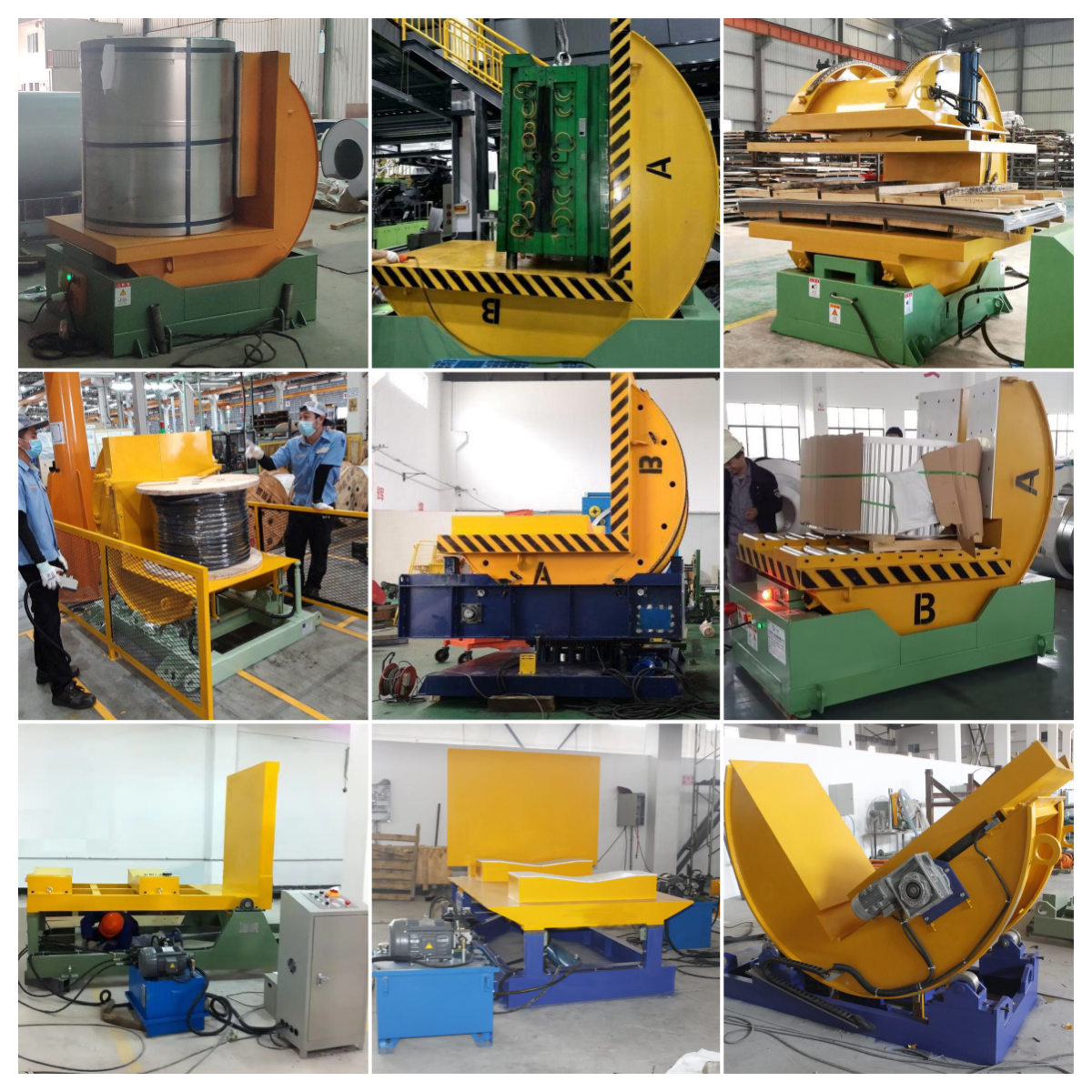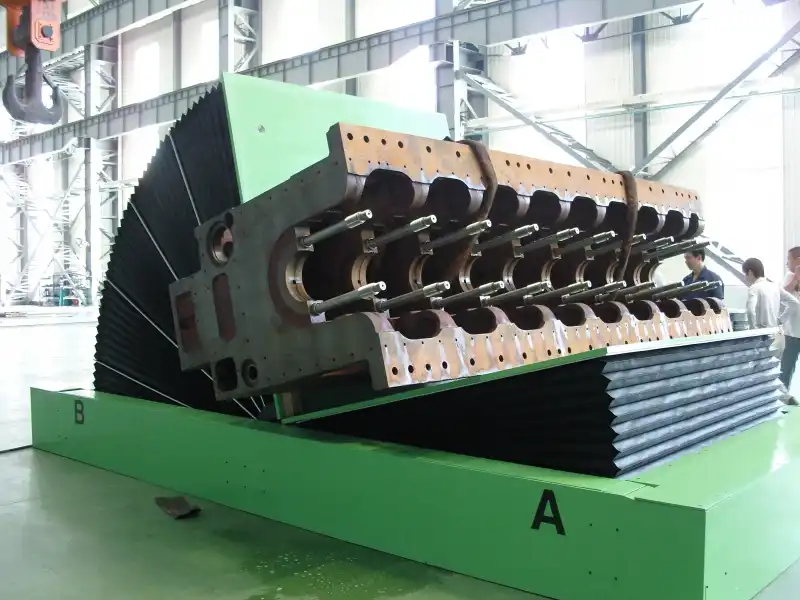What Type of Mold Upender Delivers the Best ROI for Mexico’s Manufacturing Sector?
Are you running a steel mill or a large manufacturing facility in Mexico? Then you know the pressure. Every piece of equipment must justify its cost. You face fluctuating energy prices and aging machinery. A breakdown in a key process, like handling heavy molds or coils, can bring your entire production line to a halt. This downtime costs you money and damages your reputation. You need equipment that is not just a purchase, but a long-term investment that pays for itself through reliability, efficiency, and safety. The right choice can boost your profitability, but the wrong one becomes a constant source of headaches and expenses.
For most heavy-duty applications in Mexico's manufacturing and steel sectors, a customized hydraulic mold upender offers the best Return on Investment (ROI). Its superior power, precise control, and robust safety features directly address the industry's core challenges of handling heavy, valuable loads efficiently and securely, minimizing downtime and protecting both personnel and products.

I've been in the packaging machine industry my entire career, first as an engineer and now as a factory owner. I understand the weight of making a significant capital investment. You are not just buying a machine; you are investing in your plant's future productivity and safety. This guide is based on my years of experience designing, building, and implementing these solutions for clients just like you. We will break down the key factors to consider, moving beyond simple price tags to understand the true, long-term value of a mold upender. Let's explore how to make a choice that will strengthen your operations for years to come.
How Does a Mechanical Mold Upender Impact Long-Term Operational Costs?
Your existing equipment is over 15 years old. You see the failure rate climbing. You know that every maintenance call and every hour of downtime hits your bottom line directly. You might think a simpler, mechanical upender is a cost-effective solution. But what happens when a key gear or screw mechanism wears out? Sourcing specialized parts can be slow and expensive, leaving your production stalled. The perceived simplicity of a mechanical system can hide long-term costs related to wear and tear, maintenance complexity, and the risk of catastrophic failure without warning.
A mechanical mold upender often leads to higher long-term operational costs due to increased wear on its components, such as gears, chains, and screw jacks. While its initial purchase price may be lower, the need for regular, specialized maintenance and the higher risk of unexpected downtime from component failure can quickly erase those initial savings.

When I started my journey as an engineer, I worked on many types of machinery. Mechanical systems have a certain appeal because they seem straightforward. But in heavy industry, "straightforward" can be deceiving. The forces involved in tilting a multi-ton steel mold are immense. We need to look deeper than the initial design and consider how it performs under the relentless pressure of a 24/7 operation.
Breaking Down the Mechanical Cost Structure
A mechanical upender typically uses a screw jack or a system of gears and chains to perform the tilting motion. On the surface, this avoids the complexities of hydraulic fluid and pumps. However, this design places enormous stress on a few critical components. Let's analyze the real-world impact.
- Component Wear and Tear: The primary moving parts in a mechanical system are under constant friction and load. The threads on a screw jack or the teeth on a large gear are prone to wear over time. This wear is not always linear. It can accelerate as the component loses its original shape, leading to a higher risk of sudden failure. Unlike a hydraulic system that can show early warning signs like a slow leak, a mechanical failure can be abrupt.
- Maintenance Demands: Maintenance isn't just about greasing parts. It's about monitoring for wear. This requires skilled technicians and specific measurement tools. You have to schedule regular downtime for inspections, which impacts your goal of 95% equipment uptime. Replacing a large worn gear is a significant undertaking, both in cost and in the labor required.
- Energy Consumption: Mechanical systems, especially older designs, can be less energy-efficient. They often require large motors to run continuously during the operation to overcome friction and inertia. This can conflict with your goal of reducing unit energy consumption, especially with Mexico's volatile energy prices.
Mechanical vs. Hydraulic: A Cost Perspective
Let's compare the operational cost factors in a simplified table. This is how I approach feasibility analysis with my clients.
| Feature | Mechanical Upender | Hydraulic Upender | Long-Term Cost Implication |
|---|---|---|---|
| Primary Wear | Gears, screws, chains | Seals, hoses, oil | Mechanical wear is often catastrophic; hydraulic wear is gradual (leaks). |
| Maintenance | Specialized, requires disassembly | Simpler fluid/filter changes, seal replacement | Hydraulic maintenance is often faster and less disruptive. |
| Failure Mode | Sudden, catastrophic failure | Gradual, often with warning signs | Hydraulic systems are generally safer due to predictable failure modes. |
| Energy Use | Can be inefficient; high startup torque | More efficient; power on demand | Modern hydraulics offer better energy management, supporting cost-saving goals. |
For a steel mill owner like Javier, who is focused on production stability and controlling costs, the risk of a sudden, production-halting failure from a worn mechanical part is a major concern. The long-term costs are not just in the parts, but in the lost production and the challenge of managing unpredictable downtime.
What Role Does Hydraulic Power Play in a Mold Upender's Performance and Safety?
In a steel mill, safety is not a suggestion; it's a requirement. Handling a 20-ton mold is a high-risk operation. You worry about equipment failure that could lead to a catastrophic accident, injuring your team and destroying expensive assets. The thought of a load slipping or a machine failing under pressure is a constant concern. You need a system that offers not just power, but controlled, safe power. A system that has built-in fail-safes and can handle the immense forces involved without compromising the safety of your people.
Hydraulic power is fundamental to a mold upender's performance and safety, providing immense lifting force in a compact design. Its key role is to ensure smooth, controlled movement and to incorporate critical safety features like pilot-operated check valves and pressure relief valves, which prevent the load from falling in case of a power loss or system overload.

I have seen firsthand what happens when heavy load handling goes wrong. Early in my career, I witnessed an incident with a purely mechanical lifting device that failed. It reinforced a core belief for me: when it comes to immense weight, control is everything. That is why I have so much confidence in well-designed hydraulic systems. They are the standard in heavy equipment, from excavators to industrial presses, for a reason. They offer a unique combination of brute force and fine control.
The Pillars of Hydraulic Superiority
A hydraulic system works by using a fluid, typically oil, to transmit power. A pump pressurizes the fluid, which then acts on cylinders to create movement. This simple principle provides several powerful advantages for a mold upender.
- Unmatched Power Density: Hydraulics can generate enormous force from relatively small components. A hydraulic cylinder with a small diameter can lift many tons. This means you can have a very powerful machine without it taking up excessive floor space in your plant. This is crucial for integrating new equipment into an existing production line.
- Smooth and Precise Control: The flow of hydraulic fluid can be regulated with incredible precision using valves. This allows the upender to start and stop its movement smoothly, without jerking. This is vital when handling sensitive molds or finished steel coils. A sudden jolt can damage the product or destabilize the load. Modern systems can even have variable speeds, allowing for rapid movement that slows down at the beginning and end of the cycle for added safety.
- Inherent Safety Features: This is the most critical aspect for any plant owner. A well-designed hydraulic upender includes multiple layers of safety.
Core Safety Mechanisms in Hydraulic Upenders
Let's look at the specific safety components that are non-negotiable in a hydraulic design. I insist on these for every machine we build at SHJLPACK.
| Safety Component | Function | Why It's Critical for a Steel Mill |
|---|---|---|
| Pilot-Operated Check Valves | These valves are installed directly on the hydraulic cylinders. They lock the cylinder in place if hydraulic pressure is lost. | This is the most important fail-safe. If a hose bursts or the power cuts out, this valve prevents the load from crashing down. |
| Pressure Relief Valves | This valve automatically opens to release pressure if the system is overloaded. | It acts like a circuit breaker, protecting the machine's structure and hydraulic components from damage if an operator tries to lift a load that is too heavy. |
| Flow Control Valves | These regulate the speed of the cylinders. | This ensures a consistent, controlled tilting speed, preventing dangerous, uncontrolled movements and allowing for gentle handling of the mold. |
| Emergency Stop (E-Stop) | A button that immediately cuts power to the hydraulic pump. | Provides an instant way for any operator to halt the machine in an emergency, a fundamental requirement for plant safety. |
For a CEO managing a 2 million-ton steel plant, these features are not just technical details. They are essential risk management tools that protect your investment, your product, and most importantly, your people.
Can Customization Truly Maximize the ROI of a Mold Upender?
You've faced this problem before. You buy a standard, off-the-shelf machine, and it's almost right. But "almost" creates inefficiencies. It doesn't quite fit the space. The controls don't integrate with your central system. The capacity is either too low, creating a bottleneck, or too high, meaning you paid for power you don't use. These small compromises add up, chipping away at the machine's potential ROI and frustrating your team. You know there has to be a better way than forcing a standard solution into your unique operational workflow.
Yes, customization is the single most effective way to maximize the ROI of a mold upender. By tailoring the machine's capacity, dimensions, control systems, and safety features to your specific workflow and facility, you eliminate inefficiencies, enhance safety, improve throughput, and ensure seamless integration with your existing production lines, directly boosting productivity and profitability.

I believe that a machine should serve the process, not the other way around. At my factory, SHJLPACK, we don't just build machines; we build solutions. This philosophy came from my early days as an engineer, seeing clients struggle with one-size-fits-all equipment. I remember a client in the steel wire industry who was losing time on every coil because their standard tilter's platform was slightly too small, requiring extra manual handling. A simple customization to the platform size solved the problem and paid for itself in months. This is the power of a tailored approach.
The Value of a Purpose-Built Machine
When you invest in equipment, you're buying a tool to solve a problem. The more precisely that tool is designed for the task, the more effective it will be. Let's move beyond theory and look at the concrete areas where customization delivers tangible returns.
- Right-Sizing for Capacity and Dimensions: A standard upender might be rated for 10, 20, or 30 tons. What if your most common load is 18 tons? Buying a 20-ton machine is appropriate, but what if the next step up is 30 tons? You'd be paying for a heavier structure and a more powerful hydraulic system than you need. Customization allows you to specify the exact load capacity. The same goes for the table size. We can design the platform to perfectly match your mold or coil dimensions, reducing the machine's footprint and ensuring a secure fit.
- Integration with Your Digital Ecosystem: You have a goal to deploy MES and IoT platforms for production visualization. A standard upender with a simple button controller won't help you achieve that. A customized machine can be built with a PLC (Programmable Logic Controller) that speaks the same language as your other systems. We can integrate sensors to track cycles, measure weights, and send data directly to your MES. This turns your upender from an isolated piece of equipment into an intelligent node in your digital factory.
- Enhanced Safety for Your Specific Risks: Every factory floor has unique risks. Maybe the upender is near a high-traffic forklift lane. We can integrate light curtains or area scanners that automatically stop the machine if a person or vehicle enters the danger zone. Maybe you need specific lockout/tagout procedures. We can design the controls and electrical cabinet to facilitate your exact safety protocols.
Customization in Action: Solving Real-World Problems
Here’s how I would map specific challenges to custom solutions for a steel mill owner like Javier.
| Challenge | Standard Machine Problem | Customized Solution | Direct ROI Impact |
|---|---|---|---|
| Production Bottleneck | Upender cycle time is too slow for the production line's pace. | Optimize hydraulic pump and valve configuration for faster, yet controlled, cycle times. | Increases throughput and overall plant efficiency. |
| Floor Space Constraints | Standard machine footprint is too large for the designated area. | Design a more compact frame or a different machine orientation (e.g., L-shape platform). | Optimizes plant layout without costly facility modifications. |
| Digital Transformation Goal | Basic controls do not connect to the plant's MES. | Integrate a compatible PLC with an Ethernet port for data communication and remote monitoring. | Enables data-driven decisions and predictive maintenance. |
| High Energy Costs | Motor runs constantly, wasting electricity. | Implement a "power-on-demand" hydraulic system where the pump only runs during the cycle. | Directly reduces electricity consumption and lowers operational costs. |
Investing in a customized upender is not an extra cost. It is an investment in efficiency, safety, and future-readiness. It is the most direct path to achieving a higher ROI because the machine is built from the ground up to serve your specific operational and strategic goals.
My Insights
Javier, I've read your profile, and I see a reflection of my own journey. You started in the trenches of the steel industry and built a massive operation through expertise and strategic thinking. You are not just a manager; you are an engineer and an entrepreneur. Like you, I started as an engineer on the factory floor. I learned what works and what doesn't, not from a textbook, but from seeing the machines in action. That experience is what led me to start SHJLPACK. I wanted to build not just machines, but partnerships.
You are looking for a strategic partner, not just a supplier. This is the core of our mission at SHJLPACK. A supplier sells you a box. A partner understands your challenges—the pressure of energy costs, the reality of aging equipment, and the need for stringent environmental compliance in Mexico. A partner works with you to solve those challenges.
Your goal to increase equipment uptime to 95% through predictive maintenance aligns perfectly with a move towards smart, customized hydraulic upenders. A standard machine with basic controls is a black box. A custom-built, PLC-integrated upender is a source of valuable data. It can tell you its cycle count, its operating pressure, and its running hours. This data is the foundation of any predictive maintenance program. It allows you to move from fixing broken machines to preventing them from breaking in the first place.
You want to reduce unit energy consumption by 10%. We can help you achieve that. A customized hydraulic power unit can be designed for maximum efficiency. We can use variable displacement pumps and "power on demand" systems that only consume significant energy when the machine is actually moving. This is a direct attack on the energy cost challenge you face.
Most importantly, you are driving a digital transformation. You are investing in MES and IoT. Your equipment must be part of that vision. I've helped many clients bridge the gap between their heavy industrial machinery and their modern digital platforms. We design control systems that don't just operate the machine but also communicate seamlessly with your plant-wide network. This provides the total production visualization you're aiming for.
As one engineer to another, I know you analyze every investment for its ROI. The true ROI of a machine like a mold upender isn't in the purchase price. It's in its reliability over 20 years. It's in the uptime it delivers. It's in the safety of your crew. It's in its ability to adapt to your future needs. My journey to financial independence was built on this principle: delivering long-term value. That is what I am dedicated to sharing with others now. Let's have a conversation, not about selling you a machine, but about designing a total solution that helps you hit your targets for efficiency, digitization, and profitability.
Conclusion
Choosing a customized hydraulic mold upender is the most strategic investment for Mexico's demanding manufacturing sector, ensuring maximum safety, efficiency, and long-term ROI in a competitive global market.




